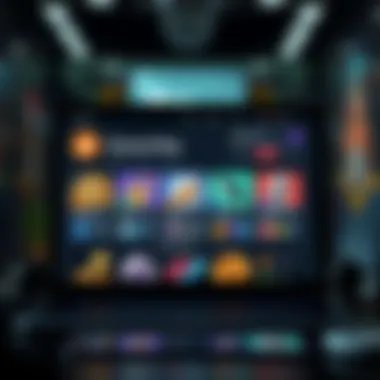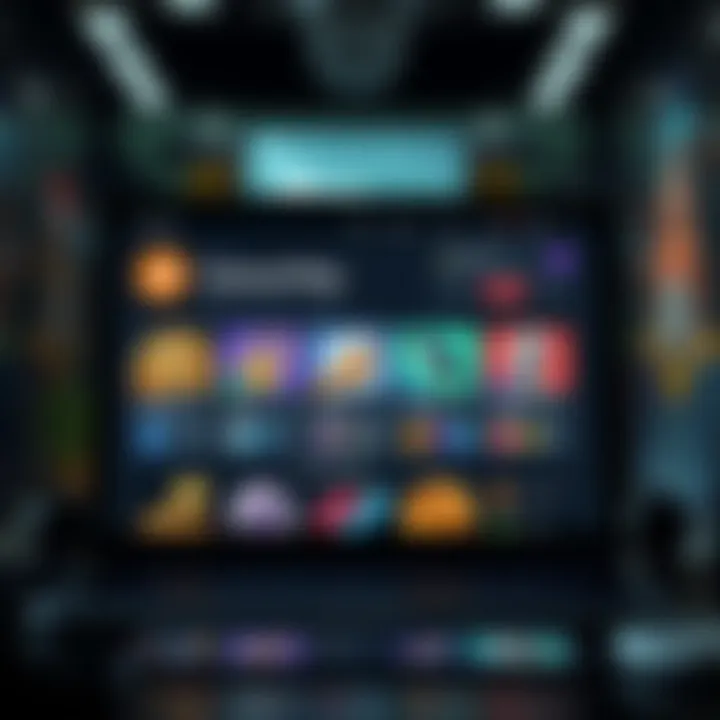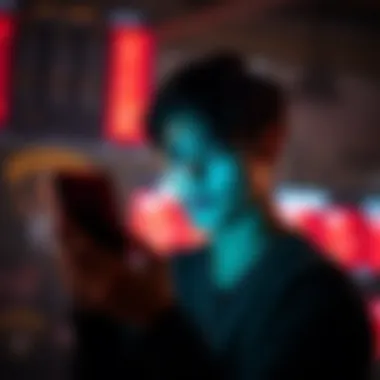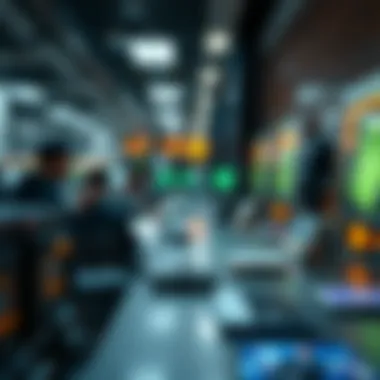Exploring NFT Creator Apps: Features and Insights


Intro
In recent years, the digital landscape has seen a surge in the popularity of Non-Fungible Tokens (NFTs), fundamentally shifting how we perceive ownership, especially in art and digital collectibles. As more creators dive into this intriguing space, understanding the tools available for NFT generation becomes vital. This is where NFT creator apps come into play. They provide users—from artists to brand marketers—with the capability to mint, manage, and sell their digital assets on various blockchain platforms.
This guide aims to shed light on the mechanics of NFT creator apps, detailing their features, functionalities, and the broader implications for creators and investors. The journey through this article will cover everything from basic terminology to market trends, ensuring both beginners and seasoned investors grasp the essentials.
Investment Dictionary
Definition of Key Terms
To get a solid foothold in the world of NFT creator apps, it’s essential to familiarize oneself with the relevant vocabulary.
- NFT (Non-Fungible Token): A type of digital asset that represents ownership of a unique item or piece of content on a blockchain. Unlike cryptocurrencies like Bitcoin, NFTs cannot be exchanged on a one-to-one basis due to their distinct nature.
- Minting: The process of creating an NFT by uploading digital content to a blockchain where it is authenticated and established as a token representing ownership.
- Marketplace: A platform where NFTs are bought and sold, such as OpenSea or Rarible, where creators can showcase their work to potential buyers.
Breakdown of Terminology Usage
A nuanced understanding of the terms is crucial for effective communication in this evolving sector. For instance, when discussing the minting process, one might highlight the difference between using Ethereum and other blockchains like Tezos or Solana, each of which has its own unique advantages and drawbacks based on transaction fees, environmental concerns, and community support.
- Gas Fees: Refers to the charges paid to facilitate transactions on blockchains that rely on miners to validate and confirm operations. High gas fees could deter potential NFT creators who want to keep costs low.
- Token Standards: Refers to the protocols that define how NFTs are created and managed on different blockchains, such as ERC-721 for Ethereum.
"Understanding each term in the NFT landscape is like having a compass; it guides creators through the uncharted waters of digital asset ownership."
As you navigate NFT creator apps, being equipped with this vocabulary not only enhances your comprehension but also enables you to engage more meaningfully with communities and platforms centered around NFTs.
By recognizing these terms and their applications, you can better understand how NFT creator apps function, allowing you to leverage these tools effectively for your own digital creations and investments.
Prolusion to NFT Creator Apps
In a world increasingly characterized by digital innovation, understanding NFT creator apps is essential for anyone wishing to dive into the realm of digital collectibles and asset ownership. These applications play a pivotal role in allowing artists, creators, and even investors to not only create but also showcase and monetize unique digital creations. The significance of these apps stretches far beyond simple tools; they represent a shift in how art is created and consumed.
To truly grasp this evolution, we must first unpack what NFTs are and what capabilities these creator apps offer. They’re a blend of technology and creativity, opening up pathways to previously unimaginable opportunities. Thus, we can appreciate their importance in reshaping the landscape of digital art and ownership, in some ways flipping the traditional art world on its head. From individuals carving out their distinct voices in the digital marketplace to seasoned investors looking for the next big thing, NFT creator apps cater to a wide audience seeking to engage with this dynamic environment.
What are NFTs?
NFTs, or Non-Fungible Tokens, are digital certificates of ownership that exist on a blockchain, the same technology underpinning cryptocurrencies. Unlike cryptocurrencies such as Bitcoin or Ethereum, which are fungible and can be exchanged one-for-one, NFTs are unique or part of a limited series. This uniqueness gives them value in the world of digital collectibles; think of an NFT like a one-of-a-kind painting.
Every NFT is minted with specific attributes that cannot be replicated, allowing artists to embed their creativity into a verifiable digital ownership system. These tokens can represent anything from artworks and music tracks to virtual real estate and even tweets. In essence, NFTs create a narrative of authenticity, transforming the way we perceive digital ownership, diverging sharply from the traditional norms.
Emergence of NFT Creator Apps
The rapid rise of NFTs ignited the development of various creator apps tailored to facilitate the minting process, along with enhancing user experience. Just a couple of years ago, the concept of owning a digital piece of art was almost alien, but with the emergence of platforms like OpenSea, Rarible, and Mintable, this has drastically changed.
These apps allow individuals with minimal technical know-how to create, buy, and sell NFTs with relative ease. Such tools lower the barrier of entry for many artists and creators who perhaps lacked the resources or technical skills necessary to engage with blockchain technology directly.
Furthermore, these platforms often include community features, enabling creators to connect with potential buyers while offering tools that assist with marketing and engagement. With the world of digital assets rapidly expanding, NFT creator apps serve not just as functional tools but as vital gateways for creators to enter and thrive in the new digital art market.
"The rise of NFT creator apps signifies a democratisation of the art and ownership landscape. Anyone with a vision can enter this space."
As the interest in NFTs continues to evolve, understanding these creator apps becomes fundamental for both novice and seasoned users.
Keep reading as we dive deeper into the key features of these apps, the technological elements at play, and the creative opportunities they present, laying the groundwork for a comprehensive view of this fascinating subject.
Key Features of NFT Creator Apps
Understanding the key features of NFT creator apps is crucial for both artists and collectors navigating the digital art landscape. These characteristics define how effectively a creator can engage with their audience, how easily they can create unique digital items, and ultimately, how these items are valued in the marketplace. Below we explore significant elements that highlight the advantages of utilizing these platforms, the considerations they bring, and how they shape the overall user experience.
User Interface and Experience
A user-friendly interface can make all the difference when it comes to NFT creation. Imagine diving into the world of non-fungible tokens without much technical expertise. If the app’s layout is complex or it requires a PhD in computer science to navigate, it’s likely that new artists will feel discouraged. Therefore, many leading NFT creator apps prioritize intuitive design. Icons should be easily recognizable, and the layout should be logical, allowing users to swiftly move from one section to another.
Key considerations include:
- Visual appeal: An aesthetically pleasing design keeps users engaged.
- Accessibility: Features like text-to-speech or high-contrast modes can help users with disabilities.
- Guided tutorials: Onboarding processes that walk newcomers through the steps of creating and minting NFTs add immense value.
These elements combine to create an inviting atmosphere where both seasoned creators and newcomers feel supported while navigating the app.
Minting Process


Minting can sound intimidating at first, but understanding this process is key to creating an NFT. Minting translates your digital creation into a unique asset on the blockchain, making it verifiably yours. Apps often streamline this process to make it as straightforward as possible.
You typically start by uploading your digital artwork or content, which can be anything from images and videos to audio files. The app then generates a unique token that is registered on a blockchain, like Ethereum, ensuring that your creation cannot be copied or stolen.
A few notable points to keep in mind during this phase:
- Gas fees: While minting, be aware of any costs involved. These costs vary based on network traffic but are generally necessary for processing transactions on platforms like Ethereum.
- Rights and ownership: Ensure you understand the rights you’re retaining post-minting. Some platforms may impose restrictions that could affect your creative freedom later.
The ease of minting combined with clear instructions crucially impacts an artist’s ability to bring their creations to life in a digital format.
Integration with Blockchain
The backbone of NFTs is blockchain technology, and the integration of this tech in creator apps cannot be understated. This connection provides the necessary infrastructure that underpins the unique ownership of digital assets. Many creator apps choose to integrate directly with well-established blockchains to enhance reliability and trust.
When utilizing these apps, the importance of blockchain integration manifests in several ways:
- Security and transparency: Each NFT transaction is recorded on-chain, providing a history of ownership that is visible to all. This transparency fosters trust; collectors can have confidence in what they're buying.
- Interoperability: A robust app allows NFTs to function across various marketplaces. This flexibility helps artists reach wider audiences.
- Smart contract functionality: Most NFT creator apps leverage smart contracts, which automate validation processes. This means that whenever an artwork is sold, royalties can automatically be paid to the creator—ensuring they benefit from their work even in resales.
The intricate relationship between NFT creator apps and blockchain technology forms a powerful synergy that can redefine how art is owned, sold, and appreciated in the digital age.
The Role of Technology in NFT Creation
The foundations of NFT Creator Apps are fundamentally tied to technological advancements. Understanding this role unveils how technology not only shapes the way NFTs are created but also influences their engagement and marketability. Central to this exploration are the elements that bolster transaction integrity and artistry alike, significantly extending creative opportunities for digital artists and maintaining the high value of minted tokens.
At the heart of NFT creation lies the concept of www.blockchain technology, which allows assets to be verified and decentralized. This technology underscores innovation in the realm of digital art and assets, ensuring that uniqueness and ownership are easily traceable. As artists and creators navigate this landscape, the role of technology becomes critical in helping them maximize their potential in the NFT marketplace.
Smart Contracts Explained
Smart contracts are self-executing agreements encoded into the blockchain, providing security and efficiency in NFT transactions. They automatically enforce and execute the terms of a contract without the need for intermediaries. In simple terms, when conditions are met, the smart contract triggers a series of actions. For creators, this presents a seamless way to manage licenses, resale rights, and even royalties.
For instance, an artist whose work is sold as an NFT can set conditions that automatically send them royalties every time their art is resold. This feature is revolutionary, allowing artists to benefit continuously from their work. It ensures that they stay connected to their creations, even if they change hands multiple times. The advantage here isn’t just about efficiency; it genuinely redefines ownership.
Security Parameters
When dealing with digital assets, security is paramount. NFT Creator Apps employ various security parameters to protect both creators and collectors from theft, fraud, and cyber threats. Encryption protocols safeguard transaction data, rendering it accessible only to authorized users. Additionally, decentralized storage systems ensure that the NFT assets are not reliant on a single server, minimizing the risk of loss.
Researchers and tech enthusiasts have noted that the distribution of ownership through unique cryptographic signatures greatly reduces the risk of counterfeiting. Once an NFT is minted, it exists as a distinct digital key on the blockchain, virtually unbreakable. This layer of security not only builds trust among users but also establishes a digital ecosystem where creativity can flourish without constant fear of misappropriation.
"The technology behind NFTs is a game changer for artists. It’s not just about selling art but ensuring they get their fair share, time and again."
Creative Opportunities for Artists
NFT creator apps have opened a bright door for artists, letting them explore fresh avenues for innovation, expression, and reach. Unlike the traditional art market, these platforms break the mold, allowing for a much more direct connection between creators and their audience. Artists can now showcase their work globally without the gatekeepers of traditional galleries, making it a thrilling time to be a creator.
When it comes to creativity, NFT apps encourage the development of unique art forms. Artists can manipulate digital mediums in ways not previously possible. Whether it's animated visuals, 3D sculptures, or audio-visual experiences, the sky's the limit. Using blockchain, they can experiment with interactivity and gamification, which adds layers of engagement previously unheard of. This not only enhances the artwork's attractiveness but also transforms how audiences interact with art itself.
"Art is not what you see, but what you make others see." – Edgar Degas
Moreover, the financial aspect of NFTs can't be ignored. The potential for artists to earn through sales and royalties when their work is resold is a game-changer. It’s no longer just a one-and-done scenario; artists can benefit from the success of their work long after the initial sale, offering a continuous revenue stream that challenges traditional selling models.
Exploring Unique Art Forms
Diving deeper into the diverse art forms enabled by NFT creator apps, it's clear that digital art has evolved. Artists can transition from static images to dynamic content, garnering more attention and interaction. This includes integrating sound, video, and AR technology, which pushes the boundary of what art can represent.
For example, several artists have begun utilizing algorithms and coding as part of their creative process. Generative art, where the artist sets parameters for the art to evolve autonomously, is becoming increasingly popular. Platforms like ArtBlocks help artists mint generative NFTs, allowing the audience to own a piece that has never been replicated before.
Utilizing creative coding to construct art pieces enables a kind of uniqueness that traditional media struggle to compete with. Artists experimenting with AI in creating visuals have also gained traction, weaving technology in with their craft to produce startling and engaging experiences.
Collaborative Projects
Collaboration is another transformative feature of NFT creator apps. Artists, regardless of their geographical location, can team up and create projects that blur the lines between individual creativity. By inviting others into their projects, artists can bring fresh perspectives to their work, leading to unforeseen outcomes.
For instance, a digital artist could collaborate with a musician to create a combined visual and audio experience. Another possibility is artists across different mediums – for example, a poet and a visual artist – merging their talents to produce a multimedia NFT that can touch the audience in multiple ways.
Such collaborative projects not only enrich the content but often lead to cross-pollination of fan bases. When two artists collaborate, their combined audience increases exposure, creating a richer experience for both their respective followers and the broader art community. This leads to an avenue not just for creative expansion, but also for deeper community engagement.
As NFT creator apps continue to evolve, they remain a massive opportunity for artists looking to explore the realms of creativity while connecting with a global audience. For those willing to adapt and experiment, the future is laden with possibilities.


Market Dynamics for NFTs
The world of Non-Fungible Tokens (NFTs) has seen ebbs and flows akin to the tide, driven by a medley of factors that shape their market dynamics. Understanding these elements is crucial for both creators and investors, as they navigate a landscape that flickers between fervent enthusiasm and cautious skepticism. This section will peel back the layers, revealing the intricate interplay of trends, statistics, and behavioral nuances that characterize the NFT marketplace.
Current Trends and Statistics
In the ever-evolving sphere of NFTs, staying updated on recent trends is not just beneficial—it’s paramount. Recent statistics reflect a vibrant, yet volatile, marketplace. The total volume of NFT sales surged to an astonishing $25 billion in 2021, a staggering increase from just $340 million in 2020.
- Trend Spotlights:
- The growth of popular platforms like OpenSea and Rarible has transformed how artworks are bought and sold.
- Digital collectibles, especially in the sports and gaming sectors, have captured significant market share, revealing a trend toward niche collectibles.
- Seasonal spikes often coincide with high-profile auctions and partnerships, enticing both seasoned collectors and casual buyers alike.
Building on these burgeoning trends, data indicates that crypto art has become more than just a fad—it's likely here to stay. Hype may wane, but the underlying technology and community continue to foster robust interest.
"The NFT market is like a rollercoaster—thrilling rides with sharp ups and downs. It’s about knowing when to buckle up and enjoy the journey."
Investors should watch indicators such as social media engagement, transaction volumes, and community activities, as these often precede notable market shifts. Platforms are increasingly transparent about the type of content that garners interest, signaling potential avenues for creators looking to enhance their visibility and sales.
Investor Behavior and Preferences
Investors in the NFT realm are not a homogeneous group. Rather, they embody diverse motivations, ranging from art enthusiasts and collectors to savvy speculators looking to ride the trend for financial gain. Understanding these behaviors unravels the intricacies of the market.
- Collector Mindset: Many collectors seek emotional connections to their purchases, often favoring unique artistic expressions over mass-produced items.
- Speculative Investment: Conversely, a substantial percentage of investors eye NFTs as short-term investments, eagerly flipping pieces at substantial margins, akin to day trading stocks.
- Ecosystem Engagement: Active participation in online forums and social media platforms like Discord or Twitter often influences purchasing decisions as investors share insights or drop tips, creating a collaborative environment.
Ultimately, as the NFT space continues to mature, understanding investor behavior will be essential for creators hoping to leverage this marketplace effectively. Pay attention to sentiments and market signals to ensure adaptability in an unpredictable environment. The mix of diligent research and community engagement can enhance opportunities, ensuring a creator not only survives but thrives.
Comparative Analysis of Popular NFT Creator Apps
When diving into the world of NFTs, one realizes there are numerous creator apps available that all claim to offer something unique. A comparative analysis of these popular NFT creator apps is essential, as it helps potential creators discern which platform best aligns with their artistic vision, budget, and technical capabilities. Understanding the nuances between platforms is the first step towards harnessing their full potential.
Platform Features and Limitations
Each NFT creator app comes with its own set of features, tailored to different types of artists and creators. For some, user-friendliness is paramount, while others may prioritize customization options or integrated marketing tools.
- User-Friendly Interfaces: Platforms like OpenSea and Rarible are often praised for their intuitive designs. They allow novice users to navigate through the minting process without feeling overwhelmed.
- Customization Options: For artists looking to push the envelope with their creations, Mintable and Foundation provide extensive customization that appeals to more seasoned creators. These platforms support varied file formats and sizes, allowing users to express their creativity without limitations.
- Interoperability: Some applications, such as Zora, emphasize the ability to interact across multiple blockchains. Such interoperability can be a game-changer as it opens avenues for a wider audience, but it can also introduce complexities in terms of understanding different blockchain functionalities.
However, these platforms have their limitations too. For instance, while OpenSea offers vast reach, it is often criticized for high gas fees during peak network times. Conversely, Mintable, though feature-rich, may not have the same level of traffic, affecting the visibility of an artist’s work.
This blend of characteristics highlights the importance of scrutinizing each app’s offerings while considering one's own needs. Evaluating both features and limitations arms creators with the necessary information tochoose wisely.
Cost Structures and Fees
Finances play a crucial role in the decision-making process. Each NFT platform has varied cost structures, fees, and hidden costs that can significantly impact an artist's profit margins.
- Gas Fees: Most platforms embedded in Ethereum require payment of gas fees that can fluctuate wildly. For example, if you’re minting on OpenSea during a period of high demand, you might face exorbitant gas fees, which can chip away at your profits.
- Transaction Fees: Many of these applications take a cut of the sales, which ranges from 2.5% on Rarible to about 15% on some exclusive platforms. Understanding how these fees affect your pricing strategy is vital.
- Listing Fees: Some platforms charge a fee just to list an NFT. This may not be a massive inhibitory factor, but if you're a small creator, these costs can add up fast.
These monetary considerations are a major aspect for both newbies and seasoned investors alike. They serve as a stark reminder that while the digital realm offers unprecedented opportunities, financial literacy in the NFT domain is more important than ever. Evaluating these cost structures and fees ensures that artists not only choose the right platform but also optimize their financial output.
"In the world of NFTs, knowing the fine print can make the difference between profit and loss."
For more detailed comparisons, resources such as Wikipedia on NFTs and the NFT subreddit can provide valuable insights into the current landscape.
Accessibility in NFT Creation
Accessibility in NFT creation is pivotal in ensuring that a diverse range of artists and creators can engage in this emerging digital landscape. As the world of NFTs expands, it becomes vital to break down barriers that have traditionally limited access to art and technology. This section examines those barriers and the pressing need for inclusivity, while highlighting the benefits to the artistic community at large.
Barriers for Entry
The journey into the NFT realm can feel overwhelming at first glance. Various factors contribute to these barriers, making it difficult for newcomers and underrepresented artists to break into the scene. Here are a few key barriers:
- Technical Know-How: Many platforms require a decent level of technical knowledge, which can exclude individuals without strong IT backgrounds.
- Cost Implications: The fees associated with creating and minting NFTs can be a stumbling block. Artists faced with high gas fees might hesitate to participate, keeping their incredible talent locked away.
- Market Saturation: With a plethora of artists flooding the NFT market, emerging creators might struggle to gain visibility amidst established names.
Despite these challenges, solutions are emerging that work to dismantle these obstacles. More user-friendly interfaces and tiered pricing models are being developed in many applications to cater to a broader audience.
Inclusivity and Diversity in Art
Fostering inclusivity and diversity within the NFT space is essential not only for equitable opportunities but also for enriching the ecosystem as a whole. This integration results in a plethora of creative expressions from various cultural backgrounds, enhancing the vibrancy of digital art. Here are several aspects supporting this idea:


- Representation of Marginalized Voices: By embracing a diverse group of artists, the NFT community stands to benefit from a wider range of perspectives and stories. This can lead to more original and thought-provoking pieces.
- Collaborative Opportunities: Inclusive environments invite collaboration, enabling artists from different backgrounds to team up and create innovative works that wouldn’t be possible alone.
- Community Support Structures: Many NFT platforms are championing diversity by creating programs that offer mentorship and funding to underrepresented creators, helping to level the playing field.
"The more diverse the perspectives, the richer the art can become. Inclusive communities foster innovation and creativity that benefits everyone."
For more insights on accessibility and barriers in digital art, consider exploring the following resources:
Future Prospects of NFT Creator Apps
The landscape of NFT creator apps is certainly one to watch, as the digital art scene continues to expand and evolve. These platforms hold promise not just for artists but also for collectors and investors. Looking ahead, the future of these apps is rife with potential developments that could change the way we interact with art and digital ownership. This section explores the technological advancements that are on the horizon, as well as the possible regulatory implications that could shape the NFT market.
Technological Advancements
As we plunge into the future of NFT creator apps, one can't help but notice the rapid pace of technological innovation. Key advancements in blockchain technology, for instance, will likely enhance efficiency and voter security. Imagine a scenario where transactions are almost instantaneous, allowing artists to mint and sell NFTs with barely a hiccup.
Moreover, artificial intelligence is stepping into the spotlight. Artists could leverage AI tools to generate unique designs or even incorporate AI-driven analytics to better understand what their audiences want. This could lead to more personalized art experiences and may even revolutionize how art is appreciated. Imagine a feature that allows a user to interact with an AI that analyzes their preferences and suggests specific types of NFTs tailored just for them.
Another exciting prospect is the integration of augmented reality (AR) and virtual reality (VR) into NFT platforms. This could allow users to experience art in entirely new dimensions. For example, a collector could view a three-dimensional sculpture in their living room via their smartphone or headset. These advancements could not just augment the value of the art, but also create immersive experiences that capture wider audiences.
Potential Regulatory Implications
While the future looks bright for NFT creator apps, it’s important to note that with great possibilities come significant responsibilities. As NFT markets grow, so does the call for regulations designed to protect both creators and consumers.
Regulatory frameworks could address a range of issues, from ensuring transparency in transactions to protecting intellectual property rights. For instance, one major concern is that current regulations may not adequately address copyright issues, leading to disputes over ownership. If clearer laws are established, it could encourage more artists to enter the NFT space with confidence, knowing their work is safeguarded.
Additionally, environmental concerns are casting a shadow over the NFT market. Many NFTs are minted on blockchain networks that consume significant energy. As governments become more involved, there could be stricter guidelines regarding sustainable practices. This wouldn't just benefit the environment; it could also lead to innovation in how NFTs are created in a more eco-friendly manner.
In summary, the future of NFT creator apps sits at an exciting intersection of technology and regulation. As advancements unfold and regulatory frameworks develop, the potential for new opportunities across the spectrum of digital art and ownership is truly vast.
"The intersection of innovation and regulation is where the true growth of NFTs will happen."
The journey ahead for NFT creator apps promises a rich tapestry of creative, economic, and ethical dimensions to explore. Whether you're an artist, collector, or investor, keeping an eye on these developments will be crucial in navigating this ever-changing landscape.
Challenges and Criticism of NFTs
As the digital realm expands, NFTs have not avoided their share of scrutiny. Discussing these challenges and criticisms is pivotal—understanding their implications helps artists and investors navigate this complex landscape more effectively. While NFTs provide unique opportunities, several concerns need addressing to paint a fuller picture of their impact.
Environmental Concerns
One key criticism of NFTs revolves around their environmental footprint. The minting of NFTs, especially on platforms like Ethereum, relies heavily on energy-intensive proof-of-work mechanisms. This has led to escalating debates regarding their role in climate change. For instance, the process of verifying transactions on these blockchains consumes a significant amount of electricity, akin to that used by entire countries.
Many advocate for greener alternatives, such as proof-of-stake systems, which promise to lighten the load on energy resources. Consider the Polygon blockchain, which has gained attention for its lower environmental impact. For artists looking to engage in NFT creation, understanding the energy implications is essential, not only for personal ethics or brand image but also for broader societal impacts.
"NFTs are a mixed bag: they offer creative freedom but carry environmental baggage that we can’t ignore."
Intellectual Property Issues
Intellectual property (IP) is another facet that sparks concern in the NFT space. How ownership is claimed and documented can be murky. When someone buys an NFT, they often acquire a token that represents ownership of a digital work, but this doesn’t automatically confer copyright to the actual art. This confusion can lead to cases of unauthorized reproductions, where individuals exploit digital artworks without proper attribution or creator consent.
Moreover, as NFTs lure in more creators, instances of art theft are becoming alarmingly common. Artists can see their works minted and sold by third parties without any legal recourse. This casts a long shadow over the appeal of NFTs, as creators are often left wrestling with the complexities of copyright law in a digital world. To navigate these treacherous waters, it’s vital for artists to not only protect their creations but also to educate themselves about copyright stipulations and potential pitfalls.
Closure: The Evolving Landscape of NFTs
The landscape of NFTs is undeniably dynamic, having undergone immense transformations since its inception. As we navigate through the complexities of NFT creator apps, it is evident that these platforms serve as pivotal instruments in redefining the concept of ownership in the digital realm. The ever-evolving nature of NFTs means that understanding their intricacies becomes not just beneficial but essential for artists and investors alike.
In this article, we've explored various elements that highlight the significance of NFT creator apps, from user-friendly interfaces to the behind-the-scenes technology that makes minting possible. Such tools not only democratize access to digital art but also foster a new culture of collaboration and innovation among creators. Artists who may have felt confined by traditional platforms now find endless opportunities to showcase their work, engaging directly with their audience without intermediary barriers.
"NFTs are shaping a new frontier where creativity meets technology and ownership is redefined."
Summarizing Key Insights
Throughout our journey, we’ve dissected pivotal insights:
- Technological Integration: The interplay between smart contracts and blockchain technology is central to NFT creation. It ensures authenticity and security, giving both creators and buyers peace of mind.
- Market Dynamics: The fluctuating trends surrounding NFTs illustrate that this digital marketplace is far from static. Awareness of investor behaviors and preferences can guide artists and creators in positioning their work more effectively.
- Accessibility Challenges: While NFT creation offers boundless opportunities, barriers still exist. Understanding issues like environmental impact and intellectual property remains crucial as we advocate for a more inclusive art community.
- Future of NFTs: Anticipating future shifts, both technological advancements and potential regulations will play substantial roles in shaping the NFT landscape.
Looking Ahead
As we glance into the future, it becomes apparent that NFT creator apps will only continue to evolve. The eventual integration of more sophisticated technologies, such as artificial intelligence and augmented reality, may reshape how NFTs are created, bought, and sold. Artists must stay agile, embracing tools that enhance their creative processes while also addressing ethical concerns that may arise from such advancements.
Moreover, the growing acknowledgment of NFTs within mainstream sectors suggests that regulatory frameworks are likely to emerge. These regulations could offer protection for both creators and collectors, cultivating an ecosystem built on trust and transparency.
In summary, while the NFT creator app landscape is still in its infancy, the path ahead is ripe with potential. It beckons artists, investors, and enthusiasts to navigate this intriguing nexus of technology and creativity, ensuring they remain informed and adaptable to forthcoming changes.



